Well ladies and gentlemen it’s that time of year again. The time of year when a cold wind blows, the temperature doesn’t rise above thirty degrees, and snow flurries fall from the sky. What better time than now than to talk about refrigerant? It’s the slowest point in the season and it seems that when things slow down everyone is able to take a step back and look at what the market is doing and will be doing in the upcoming months.
This post will go over what my pricing predictions are in 2017 on some of the most common refrigerants used today. I am by no means a fortune teller or clairvoyant so I ask that you take these predictions with a grain of salt. My theories are based off of what I have seen happen in 2016 and what I believe will happen in 2017.
For 2017 I see it as kind of a mixed bag. I see the high possibility of two wild cards on a couple refrigerants (R-134a & R-404A) and the others I see as barely changing a dime. Before we get started digging into each refrigerant let’s take a moment and consider the following things that will happen next year in the refrigeration industry:
Considerations

- Trump – It’s worth noting that next year we will be having a ‘Donald Trump’ effect on the market. Rather this is a good thing or a bad thing is to be determined. Trump has shown that he is against regulations, against the EPA and it’s enforcement of climate changing policies, and most of all he doesn’t believe in Climate Change. All of this bodes well for the price of refrigerant. He very well may get rid of some of the phase outs and extra regulations. However, the other side of the coin is that Trump is VERY anti-China. He is against their so called currency war. He is against their trade policies. He is against dumping of their imports into the United States market. He has also talked about imposing a thirty-five to forty-five percentage tariff on Chinese imports into the United States. This would have a significant impact on not only imported refrigerant but also on US manufactured product. (If I was a manufacturer in the US and saw all the import price rising I would raise my cost too and make some extra money.) I wrote more about what impact Trump will have in another article.
- Anti-Dumping Tariffs – On top of the ‘Trump Effect,’ we also have the lawsuit filed by the HFC coalition with the International Trade Commission. For those of you that have been paying attention for the past few years I’m sure you are very well aware of it. The claim is that China is importing their refrigerants into the United States market at dirt cheap prices. They can do this because of course labor is cheaper over there but also because the Chinese goverment subsidizes these companies with the unlimited coffers of the goverment treasury. So, when this imported product hits the United State’s market it comes in at a very low price. (Sometimes $40-50 a cylinder.) The initial lawsuit was filed on R-134a and on September 30th, 2016 the Trade Commission made a preliminary ruling in favor of imposing a tariff on imported R-134a from China. The agreed percent was 137.23 on the two main Chinese companies and 188.94% on other Chinese companies. The Trade Commission released a fact sheet on this.
- Phase Outs – Along with the other two factors phase-outs is something veterans of the refrigeration industry had grown to hate. It seems that every few years another refrigerant is being pushed out and being replaced by something else. Instead of the government coming after the CFCs or HCFCS they are now coming after the friendly HFC refrigerant class. This includes your commonly used R-134a, R-404A, and R-410A. Don’t be surprised if you hear of an upcoming phase out of these in the next few months and also don’t be surprised if you see your price raise due to a recently announced phase-out.
Alright, so now that we got all of that out of the way let’s dive into it by looking at each of the common refrigerants out there today:
R-22 HCFC
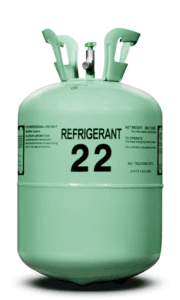
Phase-Out
Ok guys first thing’s first. If you haven’t switched your unit from R-22 and over to R-410A DO IT NOW! Your R-22 machine is at least seven to eight years old now and I’m betting that a lot of them are quite a bit older than that. On top of your machine being older it is also less inefficient than it’s HFC 410A counterpart. And finally, R-22 is extremely expensive due to the Montreal Protocol mandated phase out. Every year that passes less and less R-22 is allowed imported or produced in the United States and just like everything else the less supply there is the more demand there will be.
According to the EPA’s website, the phase out schedule of R-22 is as follows:
| Year to Be Implemented | Implementation of HCFC Phaseout through Clean Air Act Regulations | Year to Be Implemented | Percent Reduction in HCFC Consumption and Production from Baseline |
|---|---|---|---|
| 2003 | No production or import of HCFC-141b | 2004 | 35.0% |
| 2010 | No production or import of HCFC-142b and HCFC-22, except for use in equipment manufactured before January 1, 2010 | 2010 | 75.0% |
| 2015 | No production or import of any other HCFCs, except as refrigerants in equipment manufactured before January 1, 2020 | 2015 | 90.0% |
| 2020 | No production or import of HCFC-142b and HCFC-22 | 2020 | 99.5% |
| 2030 | No production or import of any HCFCs | 2030 | 100.0% |
Now, you may have noticed we’ve hit the majority of these dates already. Remember how I said your R-22 unit is getting old? As shown above no new machines from 2010 or greater can be manufactured with R-22. So, if you have an R-22 machine it is approaching or is already over ten years old. Worst of all, if your unit springs a leak and you run out of refrigerant you face paying a large sum of money just to replace your R-22.
Price
Let’s talk about price now. I’ve been writing my price per pound articles for the past three years now and each time I write one the price of R-22 keeps on climbing up. (My latest price per pound article can be found here.) In my 2015 article R-22 was retailing at about $300 per thirty pound cylinder. In my 2016 article R-22 was retailing at about $480.00 for a thirty pound cylinder. In my latest article that I wrote only a few days ago for the 2017 year R-22 is between $600-$700 for a thirty pound cylinder. That $300 price back from 2015 for a thirty pound cylinder will now only get you a ten pound cylinder for the same amount of money. It’s amazing at how fast the price can go up.
As you can see the price of R-22 is continuing to climb. The past two years it has gone up thirty percent consistently. My prediction for the 2017 year is more of the same. Let’s call the current price $650.00 for a thirty pound cylinder. That’s a happy medium between the $600-$700 that I’ve been seeing. If we do the below math we will get the number of $928.00.
$650.00 / (1-.30) = $928.00 for a thirty pound cylinder.
So there you have it folks. Next year’s predicted price for a thirty pound cylinder of R-22 is set at $928.00. If you are looking to buy some I would suggest to buy it now before the price climbs any higher. However, if you are on the other side of the coin and you have some inventory that you are sitting on I would hold onto it and watch the value climb and climb. I’ve even heard of some people buying whole pallets a few years back and storing it away in their warehouse for a few years. Imagine the profit if you bought forty cylinders at $300 and then turned around and sold them at $900 a few years later.
$300 * 40 = $12,000 cost
$900 * 40 = $36,000 cost.
Profit of: $24,000
Not too bad of a deal if you ask me! If you are interested in purchasing R-22 please visit our product page. Also, if you are interested in purchasing pallet quantities please visit our bulk purchasing page. Lastly, please be aware that you need to be certified with the EPA in order to purchase or handle R-22.
R-410A HFC
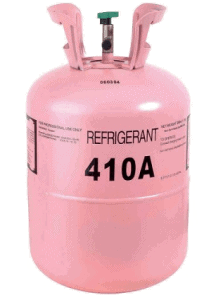
Potential Phase Out
Along with R-134a I would say R-410A is one of the most popular refrigerants on the market today. Nearly every home or commercial air conditioning unit is using or will be using R-410A for their refrigerant. It became the default refrigerant back in 2010 when it replaced the HCFC R-22 as I talked about in the R-22 section.
Now that we went through all of the work of replacing R-22 with the 410A HFC there is now talk about replacing 410A. Can they make up their minds? Even though 410A does not contain Chlorine like it’s predecessor it has been found that HFC refrigerants have a very high Global Warming Potential (GWP). 410A has a GWP of 1,725 times the effect of carbon dioxide. Basically, 410A emits Greenhouse Gases that get trapped in the atmosphere and warm the planet. Now imagine the impact that it could have if every air conditioner in the world begins using R-410A. Startling, huh? So, now the race is on to find an alternative to 410A.
So far there is no end all be all for a 410A replacement. Honeywell, Chemours, and other companies are hard at work as we speak seeking out the best alternative refrigerant with the lowest GWP. Some of the contenders are:
- R-32 – This has a GWP of 675, not the best but better than what we have now. I wrote an article about this one last year that can be found by clicking here.
- Natural Refrigerants such as R-290 and CO2 – So far these have not shown to be a cost effective solution but their GWP is VERY low.
- DR-55 – A Chemours refrigerant pending approval as R-452B. Blend of R32, R1234yf and R125. GWP of 698.
- L41z – A Honeywell refrigerant pending approval as R447B. Blend of R32, R125 and R1234ze(E). GWP of 740.
- ARM-71a – An Arkema development refrigerant with a GWP of 460.
There is no set date on when R-410A will be phased out but I foresee it as only a matter of time. Once a standard replacement has been found than the phase out will begin. This could be next year or five years down the road. It’s difficult to tell.
Price
When 410A started to become popular the price was about on par with the price of R-134a. In 2014-2015 the price hovered between $75 and $80 for a twenty-five pound cylinder. Over the past few years it has climbed about fifteen to twenty percent each year. Today the price is hovering around $130 for a retail customer. (If you purchase more than one cylinder or go in for a pallet of 410A you will save money per cylinder as well.)
Even though the price has climbed over the past few years I honestly don’t see 410A changing much in 2017. The phase out won’t be happening for a while. They haven’t even decided on a replacement product yet and when they do decide the phase out will be a staggered approach just like all of the others. If they decide on a standard replacement product in 2017 the phase out of 410A may not even start until 2022 or 2023. So, with that in mind I predict that the price of 410A in 2017 will stay relatively flat at between $130-$150 retail. Bulk purchasing may get you lower but even then you’re still looking at being in the hundreds, maybe in the high nineties if you’re lucky.
Another thing to mention on 410A is that in 2017 you do NOT need to be certified with the EPA to purchase. If you wanted you could go to Amazon.com or E-Bay.com today and purchase yourself some 410A with no regulations required. However, starting on January 1st, 2018 you will be required to be certified before purchasing or handling any HFC refrigerants including 410A, 134a, 404A, and others. (Source from EPA’s website.)
Lastly, if you are looking to purchase 410A by the cylinder I recommend Amazon.com today or E-Bay.com. If you are looking for a bulk purchase of forty cylinders or more visit our bulk purchasing page and we’ll see what we can do for you!
R-134a HFC
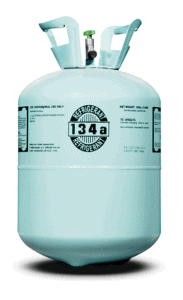
Phase-Out?
Remember those wildcards I mentioned at the beginning of my post? Well 134a is one of them. (If you haven’t noticed already by watching the market.) It was announced in the summer of 2015 that R-134a would be joining alongside R-404A in the slow phaseout of applications. The case on R-134a wasn’t nearly as drastic as it was for R-404A. The phase-out of 404A has already begun where with R-134a we still have a few good years left. (2020 is the main year for vehicles.)
R-134a days are numbered rather you like it or not. More and more newer model cars are opting for the HFO 1234YF made by Honeywell and Chemours. The Global Warming Potential of 1234YF is significantly less than R-134a and it is being pushed heavily by the United States’ Government as well as many other nation states including the European Union. Give it a few more years and 134a will be the exception instead of the rule.
The Anti-Dumping Tariff
Alrighty, ladies and gentlemen. Here were are. The tariff. You may have noticed that the price of R-134a went from about $70 a cylinder this summer all the way up to an average of $110 a cylinder over the fall and winter. This jump in price is in direct correlation to the ruling by the International Trade Commission on a anti-dumping tariff on R-134a imports from China. As I said in the beginning of this post they ruled in favor of imposing a tariff on September 30th, 2016. While this ruling is still preliminary and the final ruling won’t happen until March of 2017 the market still freaked out. (Click here for the Trade Commission’s fact sheet on the ruling.)
The standard price of $70 flew up overnight with the announcement of a proposed 137.23% tariff on all imported Chinese product. (188.94% on smaller Chinese refrigerant companies.) Can you imagine taking a 137% increase in cost for your business? I certainty can’t. This ruling is a double edged sword. If the HFC Coalition gets their way Chinese imports price will sky rocket. This will create a chasm in the market and cause every price on 134a to climb along with the imports… just like it did this fall. You, me, and everyone else will end up paying more for their refrigerant. On the other side is the preservation of American jobs and American manufacturing. We can be competitive again. We can actually buy American made product. Sounds nice huh? Do you want to pay more and save jobs… or do you want to pay those low prices and maybe put your neighbor out of work?

Pricing
Alright, so enough about all that other stuff. Let’s get to the reason you came here. What is the price of R-134a going to do next year? Up until the ruling in September the retail price on cylinders was just shy $100.00 on Amazon and E-Bay. After the ruling the price only jumped to about $115. While this may not seem like a big jump I can assure you that on the wholesale side of things we saw our price jump from $80 a cylinder all the way up to over $100 a cylinder. I believe the product that we are seeing sell for $115 online are distributors sitting on old inventory. I do not see this price lasting for long.
As for what will happen in 2017 this is a tough one to call. I do not believe the impending phase out in a few years is going to effect the pricing at this time. My big concern is the ruling on the tariff in March. What will happen if they rule in favor? What will happen if they rule against? Here are my two predictions:
- If the Trade Commission rules in favor I do not see the market adjusting much at all. I believe the adjustment already happened in early October when their preliminary announcement was made. (It jumped nearly thirty dollars a cylinder.) My prediction if they rule in favor is that wholesale prices will stay just a shy above $100 a cylinder. Retail prices will level out at about $130-$135 a cylinder.
- If the Trade Commission rules against the tariff than I can see the price plummeting back down to where it was earlier this summer. My prediction would be that wholesale pricing will be in mid $70s and retail pricing will be in the high $90s.
Lastly, if you want to purchase R-134a by the cylinder I would suggest visiting our Amazon and E-Bay partners. If you are looking for more than just a few cylinders please visit our bulk purchasing page and we will get you in contact with some of our distributors.
R-404A HFC
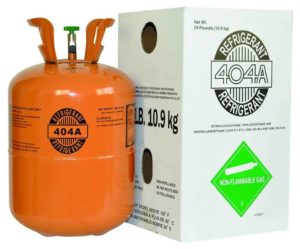
So-Called Phase-Out
This is the other wildcard of 2017. No one really knows what’s going to happen on the price of 404A as there are so many cards in play in 2016, 2017, and 2018. Starting in July 20th, 2016 the initial phase-out began. While the July date only imposed a ban on retrofitting existing machines over to 404A it was just the beginning. The next big date on 404A phase-out is January 1st, 2017… you know only a few weeks away. The order and the types of machines affected can be very confusing. Instead of trying to explain everything in text I figured it would be easier to review in a table or picture.
I pulled these tables directly from the Chemour website. All credit goes to them for compiling the data.
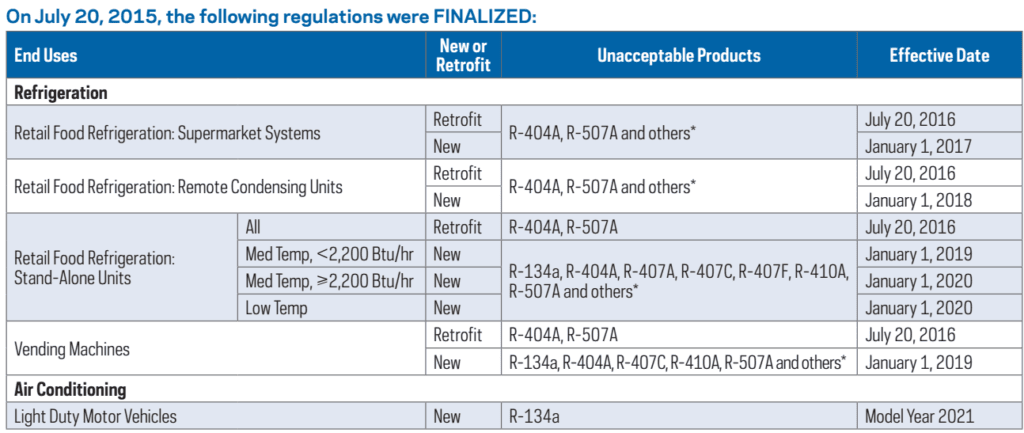
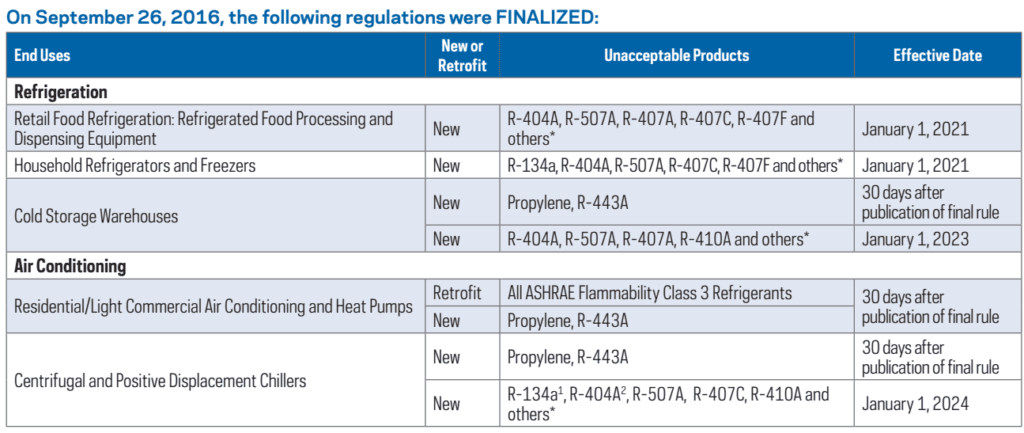
As you can see from the above tables this is the beginning of the end for 404A. July 2016, January 2017, January 2018, and so on. The big thing to mention though is that 404A will no longer be accepted in these machines it is NOT at this point in time being phased out. Let me rephrase that: R-404A is not being phased out yet but it’s use in certain machines is. So, unlike R-22 where the applications were limited and the production/imports were phased out R-404A is not being phased out. It is just having it’s applications severely limited. Their strategy could very well be phasing out 404A by starvation. If there are no more legal applications what would we use R-404A for anyways? It’s a roundabout way of going about it but maybe this will be the new way to rid the world of HFC refrigerants.
Price
So, what are we looking at as far as price on R-404A next year? Well, before we look to the future let’s look at the past. In 2015 we were at about $90-95 for a twenty-four pound cylinder of R-404A. The price went up slightly in July of 2015 when the EPA announced their intention to phase out R-404A starting in July of 2016. I believe almost everyone saw it coming anyways so it came as no surprise. After a few months the price leveled out and has remained fairly constant for the rest of 2015.
The price began to climb again in 2016. As shown in the above table the first phaseout was this July with the ban on retrofitting. In just a few weeks the next ban hits. As of right now the price online on Amazon and E-Bay are between $110 at the lowest and at $175 at the highest. It is honestly very difficult to say what’s going to happen next year. The phase out of machines using R-404A inclines me to believe that the price will go up. But, on the other hand there is no official reduction in R-404A production, only the shrinkage of machines using it.
Because of the supply remaining the same but the demand slowly shrinking I predict R-404A to actually go down in price next year. My prediction is that we will see single cylinder price at the end of next year hovering right around $85-$90 a cylinder. We’ll see if I’m right!
If you’re interested in purchasing R-404A by the cylinder I advise you to check out our Amazon and E-Bay partners for the best deal. If you’re looking at purchasing more than a few cylinders at a time please check out our Bulk Purchasing page and we will see what we can do for you.
1234YF HFO
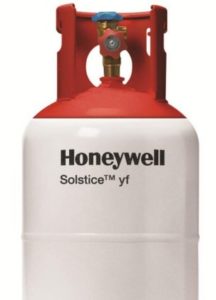
Background
1234YF is one of the highest priced refrigerants on the market today. A ten pound cylinder goes between $700 to $800 a cylinder. This is substantially higher than it’s HFC counter part R-134a. The reason this HFO is so high in price is due to the demand. At this point in time there just isn’t that much demand for it. Even as I write this towards the end of 2016 the majority of vehicles in the United States are still using the trustworthy HFC R-134a for their refrigeration systems.
While 1234YF is the minority today it won’t be for long. There is already a scheduled plan to phase out R-134a across the United States starting in 2020. (2021 model years on vehicles.) The phase out will be staggered like most of the other refrigerant phaseouts but the process will start in only three short years. Hard to believe 2020 is that close. On top of our phase out the European Union has already phased out R-134a entirely and has moved the majority of their new vehicles over to 1234YF or to other lower Global Warming Potential alternatives.
Price
Over the course of 2016 the price of 1234YF has fallen, albeit slowly. We started the year right around $750 and we are ending the year at a price at or just below $700 for a ten pound cylinder. If I was to predict what would happen next year I would say almost exactly the same thing as this year. The addition of more cars to the marketplace will create more demand for manufacturing. Honeywell and Chemours will respond accordingly and start to add more of it to the market. This will be a slow creep effect and I could see at the end of 2017 that we will be looking at a price of around $620-$650 a cylinder.
As the years roll by and the refrigerant becomes more popular I see us going under $500 but not much lower than that. When the phaseout of 134a starts in 2020 I could see 1234YF jumping up in price for a a few months but as the phaseout wears on the price of 1234YF will settle back down to around $500-$600. In my opinion, the days of lower priced HFCs are gone. HFO’s will always be higher than what we are used to today with our low cost environmentally damaging HFCs.
My final prediction for 2017 on 1234F is $635.00 for a ten pound cylinder this time next year.
If you are interested n purchasing 1234YF than I suggest your visit our friends over at Refrigerant Depot. We’ve been partnered with them for the past couple years and they have provided the best product and service to our customers.
Conclusion
As I said at the beginning of this post these predictions are just that… predictions. No one knows exactly what will happen next year and anyone who claims to know is making it up! Here’s hoping that I’m right on 1234YF and 410A and am dead wrong R-22! No one wants to see the price go up. (Well at least I don’t.)
I hope all of you enjoyed my post and my fortune telling on next year’s market trends. Here’s to a happy new year and I wish everyone the best sales next summer!